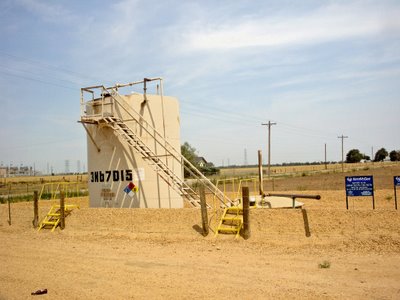Oil and Gas: Air Pollution King of Colorado
 Oil and gas developments, like the natural gas well and condensate tank above, are the largest stationary source of smog forming compounds in Colorado. They also release more toxic air pollutants, including formaldehyde, than any other stationary source of air pollution in the state.
Oil and gas developments, like the natural gas well and condensate tank above, are the largest stationary source of smog forming compounds in Colorado. They also release more toxic air pollutants, including formaldehyde, than any other stationary source of air pollution in the state. That's what a Rocky Mountain Clean Air Action analysis reveals. The analysis, which is based on industry's own data on file with the Colorado Air Pollution Control Division, shows:
- Oil and gas developments release more smog forming compounds than any other source of air pollution in the state. They emit 71% of all smog forming compounds, also known as volatile organic compounds, released from all stationary sources. These pollutants are the primary source of smog in Colorado and are toxic.
- Collectively, oil and gas developments release 27,628 tons of nitrogen oxides a year into the air of Colorado, equivalent to the amount released by nearly 1.5 million vehicles each driven 12,500 miles a year. Nitrogen oxides contribute to acid rain.
- Oil and gas developments release 18,523 tons of carbon monoxide into our air every year, more than twice the amount released by all coal and natural gas fired power plants in Colorado combined.
- Oil and gas developments in Weld County release over 50,000 tons of smog forming compounds, or 73% of all smog forming compounds released from oil and gas in Colorado.
- Collectively, oil and gas developments in Weld County release more than 50%of all smog forming compounds released by stationary sources in the state. This means that oil and gas developments in Weld County are the largest source of smog forming compounds in Colorado.
- On a county level, oil and gas developments contribute over 90% of all smog forming compounds released by stationary sources in Garfield, Las Animas, Rio Blanco, San Miguel, and Weld counties. See the table below for a rundown of the stats.
| County | Total smog forming compounds from stationary sources (tons/year) | Total smog forming compounds from oil and gas | Contribution of oil and gas to pollution |
| Delta | 139.462 | 45.59007 | 33% |
| Dolores | 143.3966 | 111.7366 | 78% |
| | 7522.26 | 7173.658 | 95% |
| | 717.7976 | 485.0621 | 68% |
| Las Animas | 453.3749 | 418.5033 | 92% |
| | 1339.794 | 506.3608 | 38% |
| | 2778.249 | 2695.81 | 97% |
| San Miguel | 541.5566 | 501.0557 | 93% |
| Weld | 53371.72 | 50730.54 | 95% |
| | 338.3099 | 193.7752 | 57% |
- Since 2002, smog forming compound emissions from oil and gas developments have grown by 70% in Garfield County, 96% in Las Animas County, and over 100% in Delta County.
- Oil and gas developments are one of the most significant sources of formaldehyde pollution. They release 83% of all formaldehyde released by stationary sources in the state of Colorado. See the table below to see just how much oil and gas contributes. Formaldehyde is a known carcinogen, and is also a smog forming compound.
- Collectively, oil and gas developments also release more benzene, acetaldehyde, acrolein, hexane, toluene, and xylenes, all of which are toxic air pollutants, than any other stationary source in Colorado. See the table below for a breakdown of toxic pollutants. Click on any pollutant below for an overview of the health effects.
| Hazardous Air Pollutants | Total released in state, tons/year | Total released by oil and gas development, tons/year | Percent contribution from oil and gas |
| 1129.793 | 938.7912 | 83% | |
| 866.0312 | 575.2221 | 66% | |
| 164.2546 | 101.7457 | 62% | |
| 61.18229 | 45.0412 | 74% | |
| 452.4787 | 320.6739 | 71% | |
| 1137.577 | 632.7135 | 56% | |
| 891.9199 | 528.1952 | 59% |
The data clearly shows that strong rules are needed to limit emissions of smog forming compounds from oil and gas developments. Fortunately, the Colorado Air Quality Control Commission may adopt such rules. Even better, we now have a chance to voice our support; click here to find out how you can make a difference.

0 Comments:
Post a Comment
<< Home